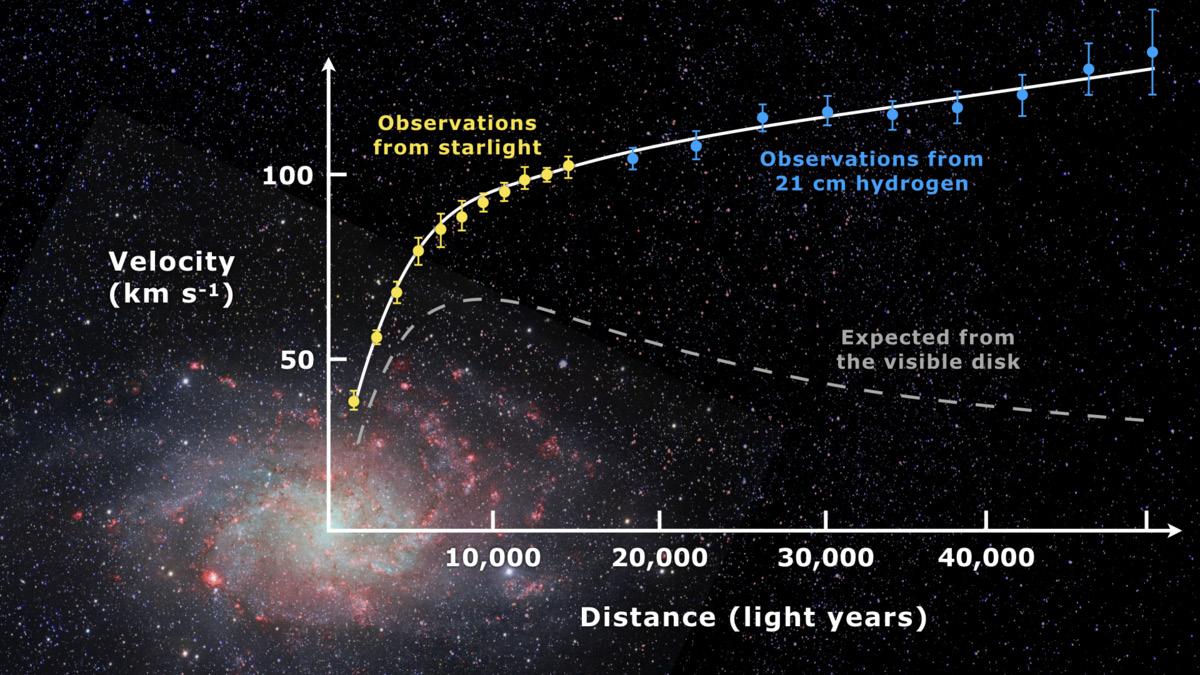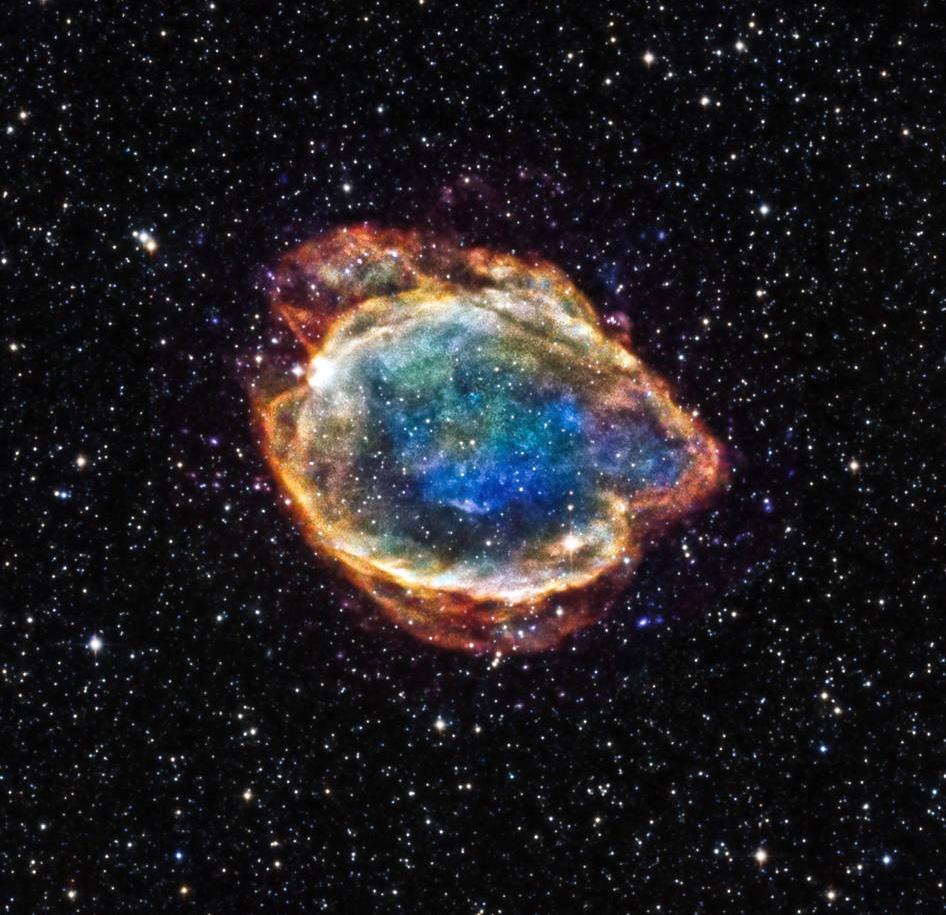
9 minute read
Dark Matter: Discovering a Glitch in the Universe Mina Nakatani
DARK MATTER: DISCOVERING A GLITCH IN THE UNIVERSE GLITCH
BY MINA NAKATANI
Advertisement
Seeing is believing. The concept seems simple enough to be considered indisputable. After all, many beliefs stem from that which is visible, and a number of scientific theories have originated from visible observations. By this logic, it would appear as though conclusions drawn through visible observations should override those made using numerical calculations; where the two disagree, a mistake in the math seems to be the most likely problem. However, this is far from true in the study of astronomy, as unseen objects can still exist, detectable only by their effects on the space around them. Dark matter is a popular example of this, pulling the strings of the universe without anyone truly understanding how it works. By exerting gravitational effects, it forces astronomical calculations to depend on factors outside the visible world—a strange glitch in scientists’ assumption of seeing as understanding. 1 Early observations of gravitational effects led astronomers and physicists to discover “invisible matter” which they believed to be merely faint stars or unseen planets. However, just as the nature of this invisible matter was underestimated, so was the degree of its presence, with early estimates suggesting that there was a lower quantity of dark matter than “non-dark” matter. 1 That changed in the 1930s with the work of Fritz Zwicky, whose research is often cited as the first true evidence of dark matter (Fig. 1). By observing the large, relatively nearby Coma Cluster, Zwicky tracked the movement of gravitationally-bound galaxies using the Doppler Effect—essentially measuring the change

Figure 1: The Coma Cluster Fritz Zwicky’s observation of redshift in the Coma Cluster, a collection of galaxies, is often cited as the earliest evidence for the existence of dark matter.
Figure 2: Rotation curve of Andromeda and other spiral galaxies.Work by Rubin and Bosma showed the outer stars in spiral galaxies to be traveling far faster than the amount of visible matter indicated in calculations. This increased velocity was attributed to a higher gravity than visible matter could provide, providing further evidence for the existence of dark matter.

in wavelength of light due to the movement of celestial objects. 2 The relative velocities of galaxies in the cluster should have corresponded to the total mass of the cluster, a number which had been estimated by the observed brightness of all the cluster’s known galaxies. However, the data did not match the expected results. Rather, the observed velocities were possible only if the cluster were much more massive than it was calculated to be—four hundred times more massive, in fact. 2 This result sharply conflicted with earlier beliefs, which stated that the universe should mostly consist of visible matter.
Nonetheless, Zwicky’s results did agree with observations made by later astronomers. In the late 1970s and early 1980s, Vera Rubin came to similar conclusions by observing the rotation curve of the Andromeda galaxy, which she deduced by plotting the velocity of stars within the galaxy as a function of their distance from the galaxy’s center(Fig. 2). 3 Given that the galaxy visibly appeared to contain far more mass at its center than in its arms, Rubin assumed that its center should rotate more quickly, as more mass at a shorter distance should exert a stronger pull on the stars relative to less mass at a greater distance. However, the stars’ velocities did not fall off with distance as she expected; instead, they evened out with distance, indicating that the luminosity, or brightness, of galaxies could not indicate the amount of mass they contained. 3 There was something missing in the theory, and astrophysicists decided that there had to be a large amount of mass unaccounted for by their initial assumptions. Moreover, this observation was not particular to the Andromeda galaxy; Albert Bosma, a PhD student writing his thesis around the same time of Rubin’s discovery, conducted the same analysis on other spiral galaxies and demonstrated the effect to be a common one. 4 This “missing mass” observed by Rubin and Bosma was also supported by calculations made by Martin Schwarzschild, an astrophysicist in the 1950s who analyzed the luminosity of a large number of galaxies, determining that in many cases, the ratio of mass to luminosity was far too large to be explained by only visible matter. 5 Following these initial discoveries, physicists and astronomers strived to explain the nature of dark matter, although early theories tended to assume the simplest possible terms. Some astrophysicists initially thought that dark matter was exactly what its name implied; it was merely
matter too dark to see. Luminous matter, such as stars, were the easiest to see, and thus were the easiest metric to use for determining how much mass appeared to be in a galaxy, as increased brightness tends to correlate with increased mass. However, objects like planets are not luminous, but still contribute to the overall mass of a galaxy as a whole. This idea of non-luminous matter provided the basis for the concept of MACHOs, or massive astrophysical compact halo objects. These MACHOs included large masses occupying space in the outer halos of galaxies, contributing to their mass yet invisible to scientific equipment. 1 Ideally, those MACHOs would bend enough light from background stars as a result of their effect on gravity—an effect called gravitational lensing—that their mass could be determined. 1 In reality, the effect observed was not large enough to account for the missing mass. 1 As a result, others looked for alternative ways to account for the necessary mass, such as attributing it to the remains of supernovae. Hypothetically, stars are capable of forming elements as heavy as nickel in their core, rather than merely hydrogen and helium; when they explode as supernovae, these heavier elements should disperse through the galaxy, again providing mass which may be too dark to see(Fig. 3). 6 However, as with MACHOs, supernova remnants could not account for enough mass, with too few supernovae existing to provide a significant enough effect. 6 Exhausting simple explanations, newer theories have turned to so-called “exot
ic matter”—particles which are unlike the normal matter people interact with on a daily basis. Neutrinos—nearly zero-mass particles which interact only with gravity and the weak nuclear force—have been proposed as a possible dark matter candidate simply due to the fact that they have been detected. 7 Trivial though that justification may seem, not all possible dark matter candidates have been detected yet. Exotic matter is only theoretical, thought to behave in ways that align with standard models utilized by physicists. 7 Axions and gravitinos are such candidates, but they provide their own sets of problems in the way that they are expected to interact with normal matter and energy. 7 Gravitinos, for example, are thought to destroy light, and depending upon the circumstances surrounding the start of the universe, they may have been overproduced, a situation implying that there is more mass than calculations are able to indicate. 7 WIMPs—weakly interacting massive particles—are yet another theorized candidate for the identity of dark matter that are thought to have been produced during the Big Bang. 8 While more massive WIMPs are theorized to be unstable, the lightest among them are thought to be relatively stable, making them popular candidates for dark matter, as they would correctly account for the amount of missing matter observed. 8 However, each type of particle is currently only a possible can

Figure 3: Remnants of a Type 1A supernova. Type 1A supernovae were thought to release elements heavier than hydrogen and helium into space, potentially making up for the discrepancy in observed mass and the mass needed to explain observations. However, too few supernovae exist to make up for this difference.

Figure 4: The current cosmological model. With further research into dark matter, dark energy, and other astronomical mysteries, physicists have settled on a cosmological model in which visible matter and energy—everything people can see and touch—make up less than 5% of the universe. Dark matter constitutes just over 20% while dark energy provides over 70%, implying that most of the universe still remains to be understood.
didate, as physicists do not know enough about them to reach a definite conclusion. Ultimately, the mystery of dark matter is yet to be solved entirely, despite the progress being made to understand it. It has revealed a complexity to the universe previously unknown, entirely upsetting the way scientists—and even the public—had long thought the world to work. Today, physicists continue to explore other mysteries alongside that of dark matter, such as dark energy, the accelerating expansion of the universe, and the present cosmological model, in which normal matter and energy make up only 4% of the universe (Fig. 4). 9 These glitches provide new mysteries to solve and new answers to chase; the revelation that “seeing isn’t always believing” is a small price to pay in comparison. Acknowledgements: I would like to thank Alex Filippenko (Professor of Astronomy, UC Berkeley) and Kishore C. Patra (Graduate Student in Astronomy, UC Berkeley) for giving their time to review the accuracy of my article and provide me with insight into the discovery of dark matter. REFERENCES 1. Bertone, G. (2018). History of Dark Matter. Reviews of Modern Physics, 90(4). 2. Zwicky, F. (2008). Republication of: The redshift of extragalactic nebulae. General Relativity and Gravitation, 41(1), 207–224. doi: 10.1007/s10714- 008-0707-4 3. Rubin, V. C. (1983). Dark Matter in Spiral Galaxies. Scientific American, 248(6), 96–108. doi: 10.1038/scientificamerican0683-96 4. Bosma, A. (1981). 21-cm line studies of spiral galaxies. II. The distribution and kinematics of neutral hydrogen in spiral galaxies of various morphological types. The Astronomical Journal, 86, 1825. doi: 10.1086/113063 5. Schwarzschild, M. (1954). Mass distribution and mass-luminosity ratio in galaxies. The Astronomical Journal, 59, 273. doi: 10.1086/107013 6. Hoyle, F. (1954). On Nuclear Reactions Occuring in Very Hot STARS.I. the Synthesis of Elements from Carbon to Nickel. The Astrophysical Journal Supplement Series, 1, 121. doi: 10.1086/190005 7. Bertone, G., Hooper, D., & Silk, J. (2005). Particle dark matter: evidence, candidates and constraints. Physics Reports, 405(5-6), 279–390. doi: 10.1016/j.physrep.2004.08.031 8. Arun, K., Gudennavar, S., & Sivaram, C. (2017). Dark matter, dark energy, and alternate models: A review. Advances in Space Research, 60(1), 166–186. doi: 10.1016/j.asr.2017.03.043 9. Frieman, J. A., Turner, M. S., & Huterer, D. (2008). Dark Energy and the Accelerating Universe. Annual Review of Astronomy and Astrophysics, 46(1), 385–432. doi: 10.1146/annurev.astro.46.060407.145243
IMAGE SOURCES 1. Photo Album :: 1E 0657-56 :: More Images of 1E 0657-56. (n.d.). Retrieved from https://chandra.harvard.edu/ photo/2006/1e0657/more.html. 2. Gill, K. (2018). Abell 2218 - Gravitational Lensing. Retrieved from https://www.flickr.com/photos/kevinmgill/40501331252. 3. Dwarfs in Coma Cluster. (n.d.). Retrieved from https://www.jpl. nasa.gov/spaceimages/details.










